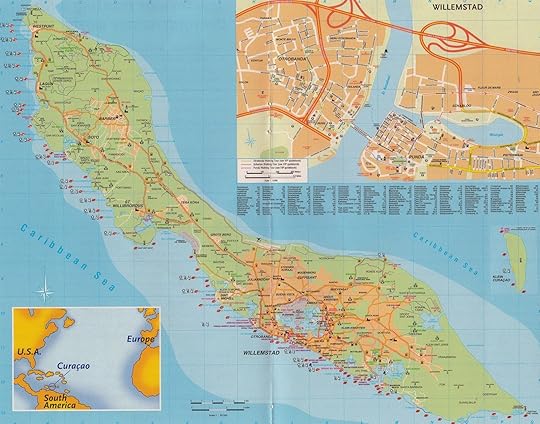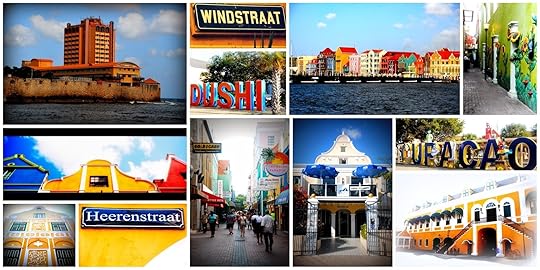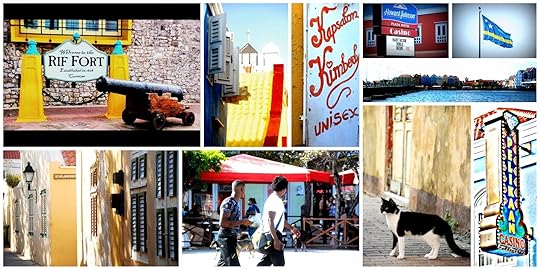Otrobanda & Punda -- Quirks of #Curaçao (#AtoZChallenge 2015)
Seeing as I missed yesterday's O post, you're entitled to a two-for-one today. And Curaçao has a unique feature for that.
Downtown Willemstad, the capital (and only) city of Curaçao, is divided--quite literally, and quite conveniently for this post--in two by the Sint Annabaai (Bay of Saint Anna). It's more of a channel than a bay--part of the natural harbor that made Curaçao so valuable to Spanish and Portuguese and Dutch merchant ships (or pirates, depending on which side you're on) back in the days when transatlantic voyaging was a novelty.

Punda (point, in Papiamentu) is on the right--on the right hand, but also, being upwind (or ariba), on the right side of the tracks--or the water, in this case. Punda was where commerce flourished; first the slave trade (Curaçao was the first port of call for slave ships into the Americas), later the lesser tarnished (if not much more ethical) forms of capitalism.
 Views of PundaAcross the water is Otrobanda (literally, other side). Downwind, abou, the wrong side of town. For a long time it lay ignored, ancient buildings falling from picturesque into plain old disrepair. Now it's where cruise ships dock, and home to the newest addition in Curaçao's hospitality industry, the Renaissance. The Rif Fort, beautifully preserved and conscientiously converted into an open-air mall, shouts silent and righteous derision across the Sint Annabaai at its once-sister fort, Fort Amsterdam, partially demolished to make way for that pink abomination, the Plaza hotel (upper left corner in the Views of Punda collage above).
Views of PundaAcross the water is Otrobanda (literally, other side). Downwind, abou, the wrong side of town. For a long time it lay ignored, ancient buildings falling from picturesque into plain old disrepair. Now it's where cruise ships dock, and home to the newest addition in Curaçao's hospitality industry, the Renaissance. The Rif Fort, beautifully preserved and conscientiously converted into an open-air mall, shouts silent and righteous derision across the Sint Annabaai at its once-sister fort, Fort Amsterdam, partially demolished to make way for that pink abomination, the Plaza hotel (upper left corner in the Views of Punda collage above).
 Views of Otrobanda
Views of Otrobanda
Downtown Willemstad, the capital (and only) city of Curaçao, is divided--quite literally, and quite conveniently for this post--in two by the Sint Annabaai (Bay of Saint Anna). It's more of a channel than a bay--part of the natural harbor that made Curaçao so valuable to Spanish and Portuguese and Dutch merchant ships (or pirates, depending on which side you're on) back in the days when transatlantic voyaging was a novelty.

Punda (point, in Papiamentu) is on the right--on the right hand, but also, being upwind (or ariba), on the right side of the tracks--or the water, in this case. Punda was where commerce flourished; first the slave trade (Curaçao was the first port of call for slave ships into the Americas), later the lesser tarnished (if not much more ethical) forms of capitalism.
 Views of PundaAcross the water is Otrobanda (literally, other side). Downwind, abou, the wrong side of town. For a long time it lay ignored, ancient buildings falling from picturesque into plain old disrepair. Now it's where cruise ships dock, and home to the newest addition in Curaçao's hospitality industry, the Renaissance. The Rif Fort, beautifully preserved and conscientiously converted into an open-air mall, shouts silent and righteous derision across the Sint Annabaai at its once-sister fort, Fort Amsterdam, partially demolished to make way for that pink abomination, the Plaza hotel (upper left corner in the Views of Punda collage above).
Views of PundaAcross the water is Otrobanda (literally, other side). Downwind, abou, the wrong side of town. For a long time it lay ignored, ancient buildings falling from picturesque into plain old disrepair. Now it's where cruise ships dock, and home to the newest addition in Curaçao's hospitality industry, the Renaissance. The Rif Fort, beautifully preserved and conscientiously converted into an open-air mall, shouts silent and righteous derision across the Sint Annabaai at its once-sister fort, Fort Amsterdam, partially demolished to make way for that pink abomination, the Plaza hotel (upper left corner in the Views of Punda collage above). Views of Otrobanda
Views of Otrobanda
Published on April 18, 2015 19:28
No comments have been added yet.



